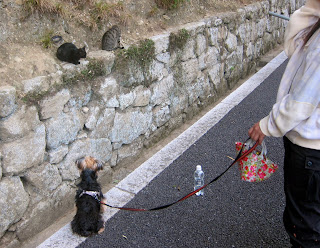2012
むらさきのの近所
むらさきのの近所
Imamiya Shrine
The Imamiya Shrine marks the northwest corner of the neighborhood. It's a shinto shrine as opposed to the buddhist temples of Daitokuji. The native-born shinto religion is animistic and worships an informal pantheon of gods or kami.
 |
| The Imamiya Shrine |
If you're in a taxi and want to visit Imamamiya Shrine tell the driver to go to Aburi Mochi -- a Kyōto delicacy that's sold exclusively by vendors outside the side gate. Is it really more famous than the shrine? Only a Kyōto native can tell.
 |
| Aburi Mochi |
Best I can do to describe Aburi mochi is: sticky globs
of very sugary roasted mochi rice on a stick basted in soy sauce
Endangered Species
 |
| The Perfect Cup of Coffee |
The Hashimoto Coffee Roaster Café, right down the street from the shrine, makes the some of best coffee I can ever remember tasting. The Hashimotos roast their own coffee beans on the spot and serve it with a little thimble of fresh cream.
 |
| Passers-by can watch the roaster |
To find the café, look for this giant torii (shinto gateway) facing Kitaōi Street, the main drag in Murasakino.
 |
| The big torii |
Pachnko
 |
| The Lucky Pachinko Parlor in Murosakino |
Pachinko is Japan's third most important pastime after baseball and sumo. You see gaudy pachinko parlors everywhere from the cities to the remote countryside, drawing players of every age and all walks of life like the one on the southeast corner of the Daitokuji neighborhood.
 |
| Pachinko Players: The game is mesmerisng |
The pachinko machine is a cross between pinball and the one-armed bandit, where the player manipulates steel balls dropping from the top of the vertical board into the pay-dirt pockets, making the steel balls collect in a tray at the bottom. The balls are traded for gifts and the gifts are trade for cash.
Pumpkins!
 |
| It's Halloween on the Shin-Omiya shopping street |
Shin-Ōmiya is the shopping street that runs to the east of Daitokuji, The merchant's association decided the American holiday is good for business so it planned a costume parade on October 27. There's no trick-or-treating in Japan but everyone loves a parade.
Meanwhile, the nation's humongous chocolate industry, which rakes in the dough on Christmas and St. Valentines Day, is waking up to opportunity to cash in on another American holiday. Check out the display for Meiji Chocolate Almonds at the local convenience store.
Pickle Industry
 |
| Pickle shop at the end of the day |
There are some high-end designer pickle establishments in the area, but this one on Shin-Ōmiya is a people's pickle shop providing pickles to the public. Japanese pickles (tsukemono) are a condiment at almost every meal and range in varity far beyond the unsophisticated Western cucumber pickle. The yellow radish root pickle, takuwan, is the standard bearer.
 |
| Takuwan: The Everyman's Pickle |
Below is the gourmet pickle guydown on Kitaoji
 |
| Fancy Pickle Guy |
Slow-cooked Ramen
For those of us who think instant ramen is balanced meal (I won't name names), they don't deserve to eat at Kinchan Rāmen. It's on Kitaōji east of the big torii and I eat dinner there pretty often. I got more superlatives for this place, but all I really need to say is it's the real thing, the culinary gem of the neighborhood. I strayed onto it when I looking for the all-night ramen yatai (cart) that used to be on the southeast corner of Daitokuji. Of course, it has vanished. Ramen tastes best when you eat it outside on a cold night, warming your hands on the bowl.
 |
| Kinchan's Chashu Rāmen |
The Public Bath
Japan's public baths, or sento, have been slowly disappearing from the urban landscape for years. But there are two of then to choose from in this immediate area, demonstrating the vitality of the neighborhood. I go to the Daitokuji Sento, which is up a back alley north of the temple complex. (I mentiioned it below in the typhoon post.)
The water is always too hot, but that's the point. You can't bring a camera in the bath area because there are naked people in there. I know what you're thinking. There's a women's bath separated from the men's bath. It's a no-nonsense bath.
Japan's public baths, or sento, have been slowly disappearing from the urban landscape for years. But there are two of then to choose from in this immediate area, demonstrating the vitality of the neighborhood. I go to the Daitokuji Sento, which is up a back alley north of the temple complex. (I mentiioned it below in the typhoon post.)
 |
| Entrance to the Daitokuji Sento |
The water is always too hot, but that's the point. You can't bring a camera in the bath area because there are naked people in there. I know what you're thinking. There's a women's bath separated from the men's bath. It's a no-nonsense bath.
The Daitokuji Cats
Every day in the late afternoon a small band of feral cats gathers on one particular stone wall on one particular pathway in the center of Daitokuji like clockwork. They're usually nowhere in sight at other times of the day. Strollers stop to watch them and have their picture taken with cats in the background. Little old ladies feed them when no one is looking. The path leads from the printmaker's studio to the nearest bus stop so I walk up and down it two or three times a day. I thought at first they were all black cats, which brought to mind miniature buddhist monks in their black robes, but I've seen a few calicos since. The Yorkshire Terrier below (Melody is the name) drags her owner to the site every day to gape.
 |
| Cat fancier Dog |


No comments:
Post a Comment